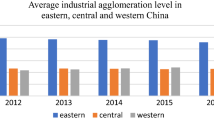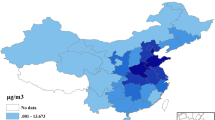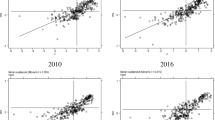Abstract
The influence of environmental regulation on haze pollution is a hot issue of scholar’s attention. However, different types of environmental regulations have different effects on haze pollution. Based on PM2.5 annual mean data of 30 provinces and cities in China from 2005 to 2016, combined with the threshold effect model to test the nonlinear impact of different types of environmental regulations on haze pollution. The results show the haze pollution in China is still serious, and there are significant regional differences in the distribution of haze pollution. The heavily polluted areas are mainly concentrated in economically developed eastern regions such as Beijing, Tianjin and Shanghai, while haze pollution in the central and western regions is relative light. The threshold effect of formal and informal environmental regulations on haze pollution has significant regional differences. Further, industrial structure and technological level will suppress haze pollution, while structure of energy consumption and openness will promote haze pollution. At last, according to the situation of different regions, we put forward different environmental regulation policies for provinces and cities to control the haze.

Similar content being viewed by others
Data availability
The data that support the findings of this study are available from the corresponding author upon reasonable request.
Abbreviations
- PM2.5 :
-
Haze pollution
- hjgz:
-
Formal environmental regulation
- fhjgz:
-
Informal environmental regulation
- ind:
-
Industrial structure
- tec:
-
Technique level
- open:
-
Degree of openness
- es:
-
Energy consumption structure
References
Apte, J. S., Brauer, M., Cohen, A. J., et al. (2018). Ambient PM2.5 reduces global and regional life expectancy. Environmental Science & Technology Letters, 5(9), 546–551.
Apte, J. S., Marshall, J. D., Cohen, A. J., & Brauer, M. (2015). Addressing global mortality from ambient PM2.5. Environmental Science & Technology, 13, 8057–8066.
Biswas, A. K., Farzanegan, M. R., & Thum, M. (2012). Pollution, shadow economy and corruption: Theory and evidence. Ecological Economics, 75, 114–125.
Bithas, K., & Kalimeris, P. (2013). Re-estimating the decoupling effect: Is there an actual transition towards a less energy-intensive economy? Energy, 51, 78–84.
Blackman, A., & Kildegaard, A. (2010). Clean technological change in developing county industrial clusters: Mexican leather tanning. Environmental Economics and Policy Studies, 12(3), 115–132.
Blackman, A., Lahiri, B., Pizer, W., Planter, M. R., & Piña, C. M. (2010). Voluntary environmental regulation in developing countries: Mexico’s clean industry program. Journal of Environmental Economics and Management, 60(3), 182–192.
Borck, R. (2019). Public transport and urban pollution. Regional Science Urban Economics, 77, 356–366.
Dai, H. W., & Hui, Y. (2019). Study on the spatial effect of Beijing–Tianjin–Hebei smog pollution, industrial structure and urbanization level. Economic Theory and Economic Management, 5, 4–19.
Dasgupta, S., Mody, A., Roy, S., et al. (2001). Environmental regulation and development: A cross-country empirical analysis. Oxford Development Studies, 29(2), 173–187.
Dasputa, P. S., Laplante, B., Wang, Hua, et al. (2002). Con fronting the environmental Kuznets curve. Journal of Economic Perspectives, 16, 147–168.
Dey, K., & Saha, S. (2018). Influence of procurement decisions in two-period green supply chain. Journal of Cleaner Production, 190, 388–402.
De Leeuw, F. A., Moussiopoulos, N., Sahm, P., & Bartonova, A. (2001). Urban air quality in larger conurbations in the European Union. Environmental Modelling & Software, 16(4), 399–414.
Domazlicky, B. R., & Weber, W. L. (2004). Does environmental protection lead to slower productivity growth in the chemical industry? Environmental and Resource Economics, 28(3), 301–324.
Dong, F., Zhang, S. N., Li, Y. F., Li, J., Xie, S. X., & Zhang, J. X. (2020). Examining environmental regulation efficiency of haze control and driving mechanism: Evidence from China. Environmental Science and Pollution Research, 27(23), 29171–29190.
Duzgoren-Aydin, N. S. (2007). Sources and characteristics of lead pollution in the urban environment of Guangzhou. Science of the Total Environment, 385(1), 182–219.
Farzin, Y. H., & Kort, P. M. (2000). Pollution abatement investment when environmental regulation is uncertain. Journal of Public Economic Theory, 2(2), 183–212.
Feng, Y. C., & Wang, W. H. (2020). Effects of urban sprawl on haze pollution in China based on dynamic spatial Durbin model during 2003–2016. Journal of Cleaner Production, 242. https://doi.org/10.1016/j.jclepro.2019.118368
Ford, H. E., Marshall, A., & Bridgewater, J. A. (2014). Docetaxel versus active symptom control for refractory oesophagogastric adenocarcinoma (COUGAR-02): An open-label, phase 3 randomised controlled trial. Lancet Oncology, 15(1), 78–87.
Frondel, M., Horbach, J., & Rennings, K. (2007). End-of-pipe or cleaner production: An empirical comparison of environmental innovation decisions across OECD countries. Business Strategy and the Environment, 16(08), 571–584.
Gehrsitz, M. (2017). The effect of low emission zones on air pollution and infant health. Journal of Environmental Economics and Management, 83, 121–144.
Greenstone, M. (2001). The impacts of environmental regulations on industrial activity: Evidence from the 1970 and 1977 clean air act amendments and the census of manufactures. Nber Working Paper, 110(6), 1175–1219.
Hepbasli, A., & Ozalp, N. (2003). Development of energy efficiency and management implementation in the Turkish industrial sector. Energy Conversion and Management, 44(2), 231–249.
Henriques, I., & Sadorsky, P. (1996). The determinants of an environmentally responsive firm: An empirical approach. Journal of Environmental Economics and Management, 30(3), 381–395.
Hettige, H., Huq, M., Pargal, S., & Wheeler, D. (1996). Determinants of pollution abatement in developing countries: Evidence from South and Southeast Asia. World Development, 24(12), 1891–1904.
Hou, J., An, Y. F., Song, H. F., & Chen, J. C. (2019). The impact of Haze pollution on regional eco-economic treatment efficiency in China: An environmental regulation perspective. International Journal of Environmental Research and Public Health, 16(21), 4059–4076.
Hou, J., Teo, T. S. H., Zhou, F. L., et al. (2018). Does industrial green transformation successfully facilitate a decrease in carbon intensity in China? An environmental regulation perspective. Journal of Cleaner Production, 184, 1060–1071.
Jiang, Z. Y., Wang, Z. I., & Li, Z. B. (2018). The effect of mandatory environmental regulation on innovation performance: Evidence from China. Journal of Cleaner Production, 203, 482–491.
Kheder, S. B., & Zugravu, N. (2012). Environmental regulation and French firms location abroad: An economic geography model in an international comparative study. Ecological Economics, 77, 48–61.
Kusdi, R. (2019). The role of green management in creating sustainability performance on the small and medium enterprises. Management of Environmental Quality: An International Journal, 30(3), 557–577.
Langpap, C., & Shimshack, J. P. (2010). Private citizen suits and public enforcement: Substitutes or complements? Journal of Environmental Economics and Management, 59(3), 235–249.
Laplante, B., & Rilstone, P. (1996). Environmental inspections and emissions of the pulp and paper industry in Quebec. Journal of Environmental Economics and Management, 31, 19–36.
Li, L., Liu, X. M., Ge, J. J., Chu, X. H., & Wang, J. (2019). Regional differences in spatial spillover and hysteresis effects: A theoretical and empirical study of environmental regulations on haze pollution in China. Journal of Cleaner Production, 230, 1096–1110.
Llop, M. (2007). Economic structure and pollution intensity within the environmental input–output framework. Energy Policy, 35(6), 3410–3417.
Lyon, T., Lu, Y., Shi, X., & Yin, Q. (2013). How do investors respond to green company awards in China? Ecological Economics, 94, 1–8.
Ma, Z. W., Sayer, A. M., Levy, R., et al. (2016). Satellite-based spatiotemporal trends in PM2.5 concentrations: China, 2004–2013. Environmental Health Perspectives, 124(2), 184–192.
Maddison, D. (2007). Modelling sulphur emissions in Europe: A spatial econometric approach. Oxford Economic Papers, 59(4), 726–743.
Marconi, D. (2012). Environmental regulation and revealed comparative advantages in Europe: Is China a pollution haven? Review of International Economics, 20(3), 616–635.
Miao, Z., Baležentis, T., Shao, S., & Chang, D. (2019). Energy use, industrial soot and vehicle exhaust pollution—China’s regional air pollution recognition, performance decomposition and governance. Energy Economics, 83, 501–514.
Mol, A., & Carter, N. T. (2006). China’s environmental governance in transition. Environmental Politics, 15, 149–170.
Nesadurai, H. E. (2017). ASEAN during the life of the pacific review: A balance sheet on regional governance and community building. The Pacific Review, 30(6), 938–951.
Oliva, P. (2015). Environmental regulations and corruption: Automobile emissions in Mexico City. Journal of Political Economy, 123(3), 686–724.
Palmer, K., Oates, W. E., & Portney, P. R. (1995). Tightening environmental standards: The benefit-cost or the no-cost paradigm? Journal of Economic Perspectives, 9(4), 119–132.
Peng, W. B., Cheng, F. F., & Lu, J. L. (2017). Research on the threshold effect of environmental regulation on provincial green innovation efficiency. Southern Economy, 9, 73–84.
Poon, J. P. H., Casas, I., & He, C. F. (2006). The impact of energy, transport and trade on air pollution in China. Eurasian Geography and Economics, 47(5), 1–17.
Purohit, P. (2007). Financial evaluation of renewable energy technologies for irrigation water pumping in India. Energy Policy, 35(6), 3134–3144.
Shen, L., & Wang, Y. Y. (2018). Supervision mechanism for pollution behavior of Chinese enterprises based on haze governance. Journal of Cleaner Production, 197, 571–582.
Song, Y., Yang, T. T., Li, Z. R., et al. (2020). Research on the direct and indirect effects of environmental regulation on environmental pollution: Empirical evidence from 253 prefecture-level cities in China. Journal of Cleaner Production, 269. https://doi.org/10.1016/j.jclepro.2020.122425
Tietenberg, T. (1998). Disclosure strategies for pollution control. Environmental and Resource Economics, 11(3–4), 587–602.
Wang, H. L., et al. (2015). PM2.5 pollution episode and its contributors from 2011 to 2013 in urban Shanghai, China. Atmospheric Environment, 123, 298–305.
Wang, X. Y., Zhang, C. T., & Zhang, Z. J. (2019). Pollution haven or porter? The impact of environmental regulation on location choices of pollution-intensive firms in China. Journal of Environmental Management, 248, 109–248.
Xu, L., Yu, Y., Yu, J., Chen, J., Niu, Z., Yin, L., Zhang F, Liao X, & Chen, Y. (2013). Spatial distribution and sources identification of elements in PM2.5 among the coastal city group in the Western Taiwan Strait region, China. Science of the Total Environment, 442, 77–85.
Zhang, M., Liu, X. X., Ding, Y. T., & Wang, W. W. (2019). How does environmental regulation affect haze pollution governance?–An empirical test based on Chinese provincial panel data. The Science of the Total Environment, 695, 133905–133912.
Zhang, M., Liu, X. X., Sun, X. R., & Wang, W. W. (2020a). The influence of multiple environmental regulations on haze pollution: Evidence from China. Atmospheric Pollution Research, 11(6), 170–179.
Zhang, M., Sun, X. R., & Wang, W. W. (2020b). Study on the effect of environmental regulations and industrial structure on haze pollution in China from the dual perspective of independence and linkage. Journal of Cleaner Production, 256, 120748–120757.
Zhang, W. S., Xiao, J., & Cai, L. F. (2020c). Joint emission reduction strategy in green supply chain under environmental regulation. Sustainability, 12(8), 3440–3463.
Zheng, Y., Peng, J. C., Xiao, J. Z., Su, P. D., & Li, S. Y. (2020). Industrial structure transformation and provincial heterogeneity characteristics evolution of air pollution: Evidence of a threshold effect from China. Atmospheric Pollution Research, 11(3), 598–609.
Zhou, Q., Zhang, X., Shao, Q., & Wang, X. (2019). The non-linear effect of environmental regulation on haze pollution: Empirical evidence for 277 Chinese cities during 2002–2010. Journal of Environmental Management, 248, 109274.
Zhou, Q., Zhong, S., Shi, T., & Zhang, X. (2021). Environmental regulation and haze pollution: Neighbor-companion or neighbor-beggar? Energy Policy. https://doi.org/10.1016/j.enpol.2021.112183
Acknowledgements
The authors would like to thank the General Projects of National Social Science Foundation of China (Grant No. 18BJY078), the National Natural Science Foundation of China (Grant No. 42071161), the General project of Philosophy and Social Science research Foundation in Hunan Province, China (Grant No. XSP20YBC051), and the General project of Science Foundation of Education Bureau Hunan Province, China, for financial support (Grant No.19C1032).
Author information
Authors and Affiliations
Corresponding author
Ethics declarations
Conflicts of Interest
The authors declare no conflict of interest.
Additional information
Publisher's Note
Springer Nature remains neutral with regard to jurisdictional claims in published maps and institutional affiliations.
Rights and permissions
Springer Nature or its licensor holds exclusive rights to this article under a publishing agreement with the author(s) or other rightsholder(s); author self-archiving of the accepted manuscript version of this article is solely governed by the terms of such publishing agreement and applicable law.
About this article
Cite this article
Kuang, C., Yu, W., Yin, Y. et al. Heterogeneity environmental regulation and provincial haze pollution in China: an empirical study based on threshold model. Environ Dev Sustain 25, 14715–14732 (2023). https://doi.org/10.1007/s10668-022-02685-w
Received:
Accepted:
Published:
Issue Date:
DOI: https://doi.org/10.1007/s10668-022-02685-w




